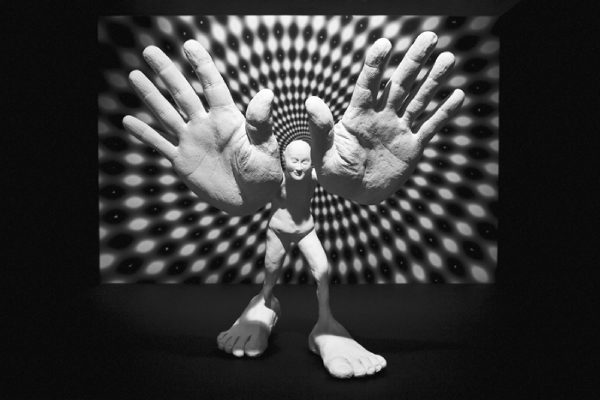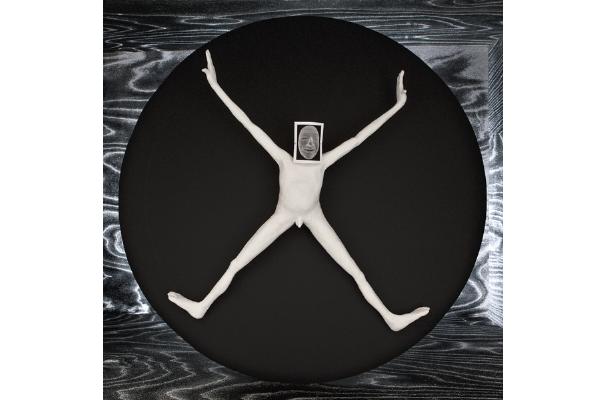
Nic Nicosia Stages the Psychological at James Kelly Contemporary
Exposing the somewhat humorous turmoil of psychodramas has been a recurring theme in photographer Nic Nicosia’s works, many of whose early photographs look as if staged behind the scenes of a television set gone wrong [the series Domestic Dramas (1982)]. In Nicosia’s newest Santa Fe exhibition In the Absence of Others (2010-11), which opened June 29 at James Kelly Contemporary, we see a departure from previous work; here it seems the artist makes “theater” of his mind alone. Conversely, and in congruence with early work (1982-2004)—as is clearly seen in photographs in which space-time-light become preoccupations for one figure—Nicosia employs a box, or stage in his photographic scenes or set-ups.
16 black-and-white photographs of varying sizes are exhibited salon-style, filling the first of two galleries at James Kelly. One or two anthropomorphic, but surrealistic and cartoon-like, male figures stand in the foreground of each photograph. Nicosia sculpted the tiny white figures, which are the subject of each photograph, from clay. The artist then staged and photographed the little men in wooden boxes, on a tiny theater set, in wheels, flying through the air on a string, or just sitting in contemplation. Although the sculpted forms are anatomically representational, exaggerated extremities distinguish them as surrealistic. A few examples: giant hands or feet, overstretched arms and legs, and numerous heads stacked one atop another like a totem pole. In the second gallery, the actual sculptures are on display behind a translucent, black scrim.

Nic Nicosia, Concentration in Bits
Nicosia’s work has long been commended for what a Dallas Morning News reviewer recently called “Jungian undertow” amid handyman tool belts (the latter, a reference to the construction that goes into each of Nicosia’s photographic set-ups). Patricia Nora, special contributor, also says in that article that Nicosia’s photographs serve as “a reminder that visual space is freighted with psychological heft.”
In the Absence of Others also portrays “psychological heft” with each tiny, white man a concoction of the artist’s mind and symbolic of different psychological states. The photograph Concentration in Bits (2011) simply shows one figure with giant hands facing forward, a swirl of psychedelic patterning in the background giving the perception of depth. Here, it seems that I am inside the artist’s mind, and the little man waves his hands to gesture, “Stop. Go no further.” Almost warning me, that going further into the rabbit hole will prove useless.

Nic Nicosia, Ready for the Ride
An audio portion also accompanies the exhibition—violin solos. While making In the Absence of Others, Nicosia learned to play the violin. The audio features his teacher playing short segments followed by the artist playing segments—the cycle of learning between teacher and student. And the Ego Goes Where (2010) could represent a mental dialogue—thoughts, doubts and dreams—that usually accompanies a period of being a novice, something Nicosia could relate to while learning the violin.
In the photographs March (2011) and Ready for the Ride (2011), we see tiny white legs and arms cartwheel within a larger wheel, but are confined to a tight, finely grained, wooden box. The box or stage, shown in almost all of the photographs in this series, might be a metaphor for the artist and his attempts to escape the box—his attempts to excel beyond his current artistic, or musical practice to create something different.
Even in the “absence” of others psychological concoctions of people persist in the mind, as does one’s sense of self. Nicosia’s little white man perhaps symbolizes the artist’s own inner voice or critic, which never seems to disappear.
Feature image: Nic Nicosia, An Illusion of Wistful Thinking, archival inkjet print, 2010
